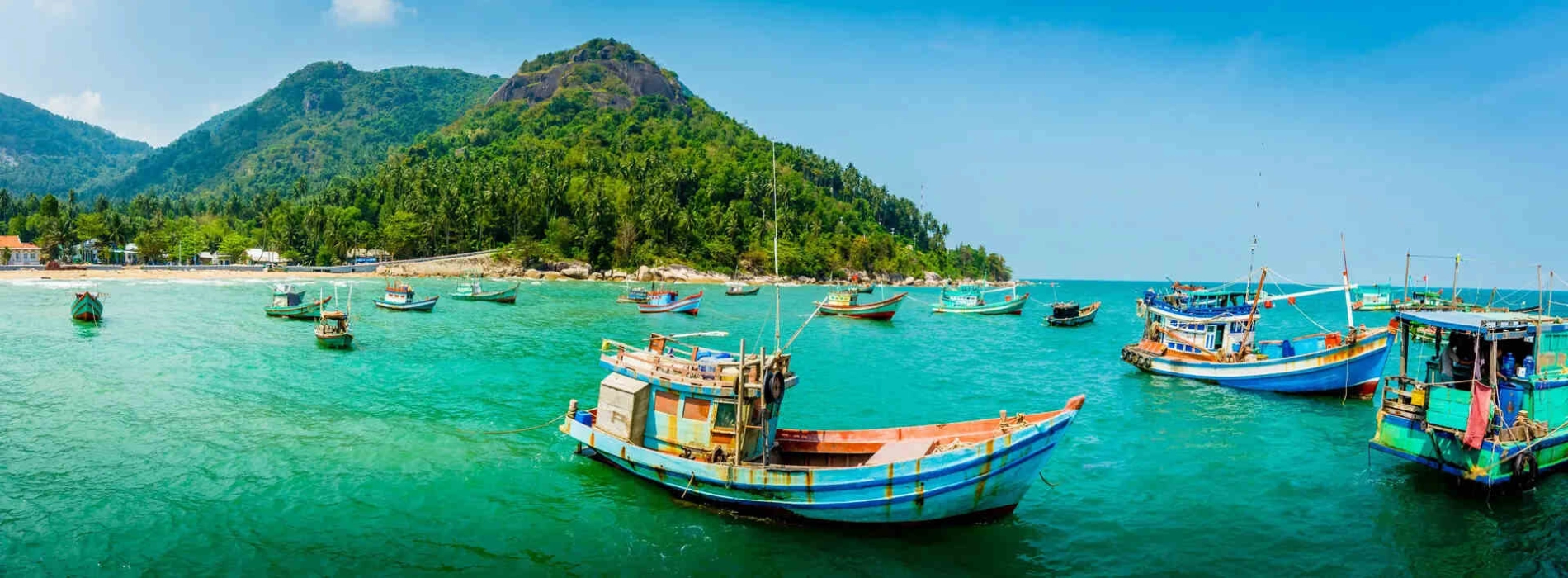Ca Mau

This tourist destination is known as "Cape Land" because Ca Mau Cape is the southernmost point of Vietnam. This place has a wild, rustic beauty and unique cultural features. This tourist destination also has a diverse ecosystem, with vast mangrove forests, pristine beaches and is also home to many rare species of animals and plants.
Ca Mau Cape tourist area seen from above. Source: camautourism
Located in the Mekong Delta region, the province borders Kien Giang, Bac Lieu, the Gulf of Thailand and the East Sea. The province has a very special geographical location with 3 sides bordering the sea, convenient for sea trade services. Let Asia King Travel provide you with useful information about this destination.
Around the end of the 16th century and the beginning of the 17th century, Vietnamese, Chinese, and Khmer people came to reside and live, forming "Ca Mau Commune". By the beginning of the 18th century, "Ca Mau Commune" belonged to Ha Tien Town. During the reign of King Minh Mang, the commune was upgraded to Long Xuyen District.
In 1947, France established Bac Lieu Province, it became a district of the province. On March 9th, 1956, the Saigon Government took Ca Mau District to establish Ca Mau Province.
President Ho Chi Minh Memorial in the Cape Land. Source: thamhienmekong
After the reunification, on January 1st, 1976, Ca Mau Province and Bac Lieu Province merged into one province called Ca Mau - Bac Lieu. On March 10th, 1976, this location was renamed Minh Hai Province. On January 1st, 1997, Minh Hai Province was split into Ca Mau Province and Bac Lieu Province.
Read more: Mekong Delta Trip 3 days 2 nights : Escape to Can Tho and Surroundings
During this period, this area typically receives a significant amount of rainfall. High temperatures and humidity are common, with occasional tropical storms or typhoons affecting the region.
The dry season is characterized by lower rainfall and more comfortable temperatures. Humidity levels are generally lower during this time.
Da Bac Island is a beautiful island cluster consisting of three large and small islands located next to each other. Source: dulichlaodong.vn
In general, the climate is quite pleasant all year round, but the best time to travel to Ca Mau is during the dry season, from December to April of the following year. The rainy season lasts from May to November. If you go around July - August of the lunar calendar, you can enjoy many specialties.
It is the last province of Vietnam's S-shaped strip, bordering the sea on three sidesThe East borders the East Sea, the West and the South borders on the Gulf of Thailand.
This is also the reason why this area is the province with the longest coastline with nearly 254 kilometers. It can be said that thanks to that prime location, Ca Mau is Vietnam’s key gateway for international exchanges via sea.
From Ho Chi Minh City to the destination , you will have to travel a distance of more than 300 kilometers. Depending on your travel schedule, the travel time from Ho Chi Minh City to this area will fluctuate between 6 - 7 hours.
Trem River Junction, Thoi Binh District. Source: Huynh Lam/Ca Mau Tourism
You start from Phu Lam roundabout, District 6 or Trung Luong Expressway, District 7 and move with the following schedule: Highway 1A – Tan An – Trung Luong – Can Tho – Bac Lieu – Ca Mau.
It is a rustic dish in locals family meal. Processing materials are snakehead fish (also known as blackhead fish, sardines, …), a benign, meaty, low-bone and protein-rich fish. After being washed, use bamboo sticks to cross the fish and bury them in the straw and light up the fire until well-done. Just separating the body of the fish into two halves will reveal the porous white fish flesh inside.
Grilled Snakehead Fish is a rustic dish in locals family meal. Source: VnExpress
A typical fish in the mangrove area, although ugly, this small fish stands out because it can swim, run on water or land and can also climb trees. And above all, mudskippers are highly nutritious, have few bones and are not fishy.
Grilled Mudskipper is a favourite dish of many tourists. Source: Traveloka
It has become a rustic specialty of this area but is a favorite delicious dish of many tourists, with a variety of ways to prepare it. You can enjoy grilled mudskippers, hot pot, braised with pepper. Or you can buy dried mudskippers as gifts for friends and relatives after the trip.
Snails have brown shells about 4 centimeters long and are as small as a man's index finger. Snails can be used to make many different dishes such as steamed, stir-fried with lemongrass and chili, or stir-fried with coconut. Especially with stir-fried Snails with Coconut, the snail meat is both chewy and crispy and fatty, very delicious.
Snails stir-fried with coconut is a specialty of the mangrove forest. Source: taucaotoc.vn
Above are the general assessments that help us understand the general overview of Ca Mau. With the beauty of wild beauty and unique landscape, this location is both a land imbued with idyllic countryside and a deep look of Great mountains and forests. Contact Asia King Travel to get an opportunity to explore this mysterious rich land to learn more about natural life and admire the unique landscapes that nature has given.
Read more: Mekong Delta Tour 3 days: Mekong Delta Eco Excursion